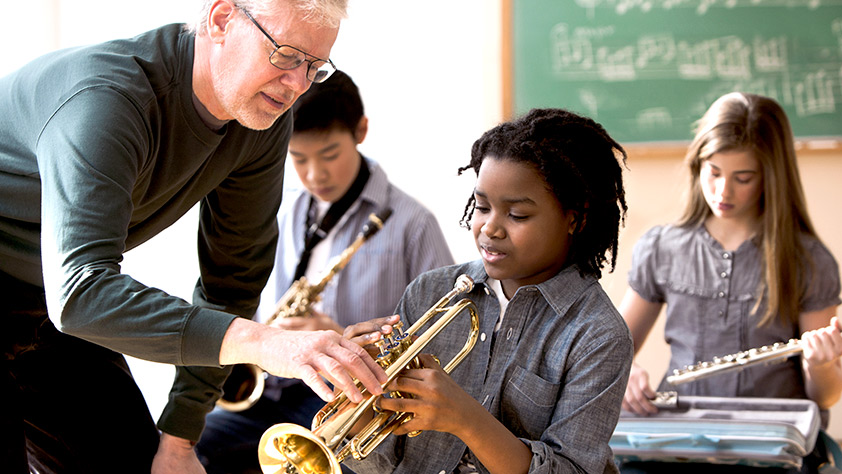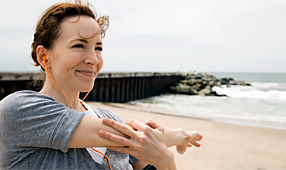According to the National Institutes of Health, one in eight Americans over age 12 has hearing loss in both ears. Age 12! That number climbs to one in four among people over age 65.
Researchers are beginning to discover that the repercussions of hearing loss extend beyond retaining the ability to follow a conversation or listen to favorite tunes. Studies show that people with hearing loss are more likely to suffer from cognitive deficits and they’re at greater risk of taking a spill, too. What’s worse, once hearing loss occurs, it cannot be reversed. Sure, hearing can improve with a hearing aid, but it can’t be corrected 100%, like vision.
Since many parts of the inner ear can’t regenerate, one of the most important factors for hearing loss is lifetime exposure to noise. And that’s a problem for educators who spend most of their time in bustling hallways, noisy sport courts and of course, loud classrooms.
“The reality is, no matter what your profession, hearing is an underappreciated sense,” explains Deanna K. Meinke, Ph.D., Professor of Audiology and Speech-Language Sciences at the University of Northern Colorado and Co-Director of Dangerous Decibels. Consider what it might be like to sit on the porch and not be able to hear the crickets chirping. To never experience the wonder of a child’s laughter. To miss out on your favorite music.
Protect your hearing now by reducing your exposure to loud noises—and simultaneously model safe listening behaviors for your students—with these three strategies.
1. Get tested. No matter what your age or predisposition, take time to get your hearing tested. Otherwise, if you lose your hearing spontaneously, doctors have no idea how to compare the loss to your baseline. But don’t rely on the school audiologist for screening. “School hearing tests are designed to find problems related to ear infections in kids, not noise-related hearing loss in adults,” says Meinke. But the school audiologist can direct you to appropriate services. If you get a referral from a physician, hearing tests are a covered service under most insurance plans. Just be sure to read up on your current policy.
Quick Tip: Get your hearing tested once every three years if you’re under age 65 and annually if you’re over 65. The caveat: If you’re constantly bombarded by loud noise—if you’re a music teacher, for example—you might consider visiting an audiologist twice a year for testing and make sure you’re wearing the appropriate protective gear.
2. Avoid loud noises. The degree of hearing damage from noise exposure is based on three variables: Intensity (how loud), duration (how long) and frequency (how often). A single gunshot can result in significant damage because it’s intense. Similarly, teaching band for hours on end takes a toll, especially if you do it daily. Not sure whether your daily dose of noise is safe? A variety of apps display noise intensity levels in decibels indicating whether exposure is risky. According to the World Health Organization, 85 decibels is the highest safe exposure level up to a maximum of eight hours. You can even take advantage of online resources like Jolene to teach students about safe listening levels.
Quick Tip: If you work in any occupation where you have to raise your voice to be heard, you should be wearing ear protection. Other common sense advice includes wearing earplugs when you’re at a loud concert, not blasting the car radio (or your iPod when wearing ear buds) and keeping background noise at a reasonable decibel.
3. Get the right gadget. If your hearing is impaired, choosing an appropriate aid is paramount. But with all of the options on the market, and no help from insurance, selecting the best hearing device can be a challenge. The good news: Today’s hearing aids are digital and highly customizable depending on the severity and location of your hearing loss.
Quick Tip: “Make sure you get a hearing aid that is appropriate for your hearing loss and that you obtain a hearing aid rather than an amplifier,” says MDHearingAid Spokesperson Sara Mulligan. If your hearing is still finely tuned, keep sounds sharp by wearing appropriate ear protection both inside and outside the classroom.
Regardless of whether your hearing is top notch or highly impaired, take advantage of useful resources within the confines of your school building, suggests Mulligan. While the on-site or consulting audiologist should not screen you for hearing impairment (as indicated above), he or she can refer you to appropriate hearing professionals—and give you helpful tools to reduce noise in the classroom. Plus, your students will learn the importance of safe listening by following your lead.
Earbuds/phones: A Glossary of Terms
Noise-blocking or noise-canceling earphones: These handy gadgets cut down background noise so users can hear their device safely, even in noisy environments, such as on airplanes, trains or the subway.
Isolated earphones: Isolated earphones seal your ear canal like an earplug, so you can listen to your device at a lower decibel level.
Output limiting earphones: Like a computer firewall, these ingenious earphones limit noise to a maximum of 82 decibels.
RESOURCES
Dangerous Decibels Training Workshops
Interactive Games About Hearing
The Jolene Educational Mannequin to determine decibel levels
The World Health Organization’s Make Listening Safe Initiative












